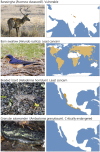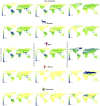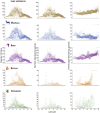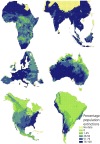Biological annihilation via the ongoing sixth mass extinction signaled by vertebrate population losses and declines
- PMID: 28696295
- PMCID: PMC5544311
- DOI: 10.1073/pnas.1704949114
Biological annihilation via the ongoing sixth mass extinction signaled by vertebrate population losses and declines
Abstract
The population extinction pulse we describe here shows, from a quantitative viewpoint, that Earth's sixth mass extinction is more severe than perceived when looking exclusively at species extinctions. Therefore, humanity needs to address anthropogenic population extirpation and decimation immediately. That conclusion is based on analyses of the numbers and degrees of range contraction (indicative of population shrinkage and/or population extinctions according to the International Union for Conservation of Nature) using a sample of 27,600 vertebrate species, and on a more detailed analysis documenting the population extinctions between 1900 and 2015 in 177 mammal species. We find that the rate of population loss in terrestrial vertebrates is extremely high-even in "species of low concern." In our sample, comprising nearly half of known vertebrate species, 32% (8,851/27,600) are decreasing; that is, they have decreased in population size and range. In the 177 mammals for which we have detailed data, all have lost 30% or more of their geographic ranges and more than 40% of the species have experienced severe population declines (>80% range shrinkage). Our data indicate that beyond global species extinctions Earth is experiencing a huge episode of population declines and extirpations, which will have negative cascading consequences on ecosystem functioning and services vital to sustaining civilization. We describe this as a "biological annihilation" to highlight the current magnitude of Earth's ongoing sixth major extinction event.
Keywords: conservation; ecosystem service; population declines; population extinctions; sixth mass extinction.
Conflict of interest statement
The authors declare no conflict of interest.
Figures






Comment in
-
Extinction tsunami can be avoided.Proc Natl Acad Sci U S A. 2017 Aug 8;114(32):8440-8441. doi: 10.1073/pnas.1711074114. Epub 2017 Jul 26. Proc Natl Acad Sci U S A. 2017. PMID: 28747527 Free PMC article. No abstract available.
References
-
- Ehrlich P-R. The scale of the human enterprise and biodiversity loss. In: Lawton JH, May RM, editors. Extinction Rates. Oxford Univ Press; Oxford, UK: 1995. pp. 214–226.
-
- Dirzo R, et al. Defaunation in the Anthropocene. Science. 2014;345:401–406. - PubMed
-
- Young HS, McCauley DJ, Galleti M, Dirzo R. Patterns, causes, and consequences of Anthropocene defaunation. Annu Rev Ecol Evol Syst. 2016;47:433–458.
-
- World Wide Fund for Nature 2016 Living Planet Report 2016. Risk and resilience in a new era. (WWF International, Gland, Switzerland). Available at wwf.panda.org/about_our_earth/all_publications/lpr_2016/. Accessed June 10, 2017.
-
- Maxwell SL, Fuller RA, Brooks TM, Watson JEM. Biodiversity: The ravages of guns, nets and bulldozers. Nature. 2016;536:143–145. - PubMed
Publication types
MeSH terms
LinkOut - more resources
Full Text Sources
Other Literature Sources

